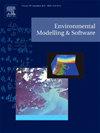Improving image-based water-level monitoring by coupling water-line detection techniques and the segment anything model
IF 4.6
2区 环境科学与生态学
Q1 COMPUTER SCIENCE, INTERDISCIPLINARY APPLICATIONS
引用次数: 0
Abstract
Image-based water level measurements offer cost-effective alternatives to traditional methods but often face challenges from environmental disturbances. We present a novel gauge image segmentation method integrating water-line detection techniques with the Segment Anything Model (adaptive-SAM) for continuous water level monitoring. The method uses adaptive prompt points derived from water line detection to generate high-quality masks of staff gauges and retrieve real-time water level data. Experiments conducted at an urban lake in southern China demonstrated the effectiveness of this integration, with the mean error reduced to 0.79 cm. The adaptive locating strategy facilitates the generation of accurate prompt points to guide SAM, thus significantly enhances its resilience to complex environmental disturbances (i.e., water texture, darkness, reflection, and overexposure) and achieves a substantial reduction in maximum errors by 22.2–41.1 cm. This simple yet robust approach provides an accessible tool for non-professionals, potentially increasing hydrological data density when traditional sensors fail.
结合水线检测技术和分段任意模型改进基于图像的水位监测
基于图像的水位测量为传统方法提供了具有成本效益的替代方案,但往往面临环境干扰的挑战。提出了一种结合水线检测技术和分段任意模型(adaptive-SAM)的水位连续监测的水位图像分割方法。该方法利用水线检测得到的自适应提示点,生成高质量的工作仪表掩模,并检索实时水位数据。在中国南方的一个城市湖泊进行的实验证明了这种整合的有效性,平均误差减小到0.79 cm。自适应定位策略有助于生成准确的提示点来引导地对空导弹,从而显著增强其对复杂环境干扰(如水体纹理、黑暗、反射和过度曝光)的恢复能力,最大误差大幅降低22.2-41.1 cm。这种简单而强大的方法为非专业人员提供了一种可访问的工具,当传统传感器失效时,可能会增加水文数据密度。
本文章由计算机程序翻译,如有差异,请以英文原文为准。
求助全文
约1分钟内获得全文
求助全文
来源期刊

Environmental Modelling & Software
工程技术-工程:环境
CiteScore
9.30
自引率
8.20%
发文量
241
审稿时长
60 days
期刊介绍:
Environmental Modelling & Software publishes contributions, in the form of research articles, reviews and short communications, on recent advances in environmental modelling and/or software. The aim is to improve our capacity to represent, understand, predict or manage the behaviour of environmental systems at all practical scales, and to communicate those improvements to a wide scientific and professional audience.
 求助内容:
求助内容: 应助结果提醒方式:
应助结果提醒方式:


